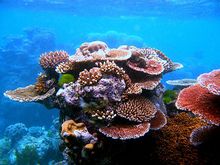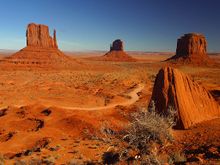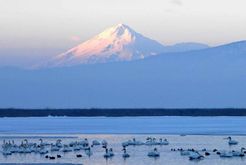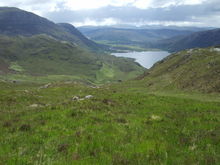Biome
Biomes are nature's major communities, classified according to the predominant vegetation and characterized by adaptations of organisms to that particular environment.[1] Biomes are often defined by abiotic (non-living) factors such as climate, relief, geology, soils and vegetation. Biomes may contain multiple ecosystems.[2]
Biomes are extremely important and have changed many times throughout Earth's history. Anthropogenic (human) activities have recently been affecting biomes,[3] which is a concern especially as energy use and greenhouse gas emissions continue to increase. Since these regions depend on a stable climate, climate change results in altered conditions within a biome.
- Major Biomes
Types
There are 5 major types of biomes:[3]
Aquatic
Water is abundant all over the Earth, making up nearly 75% of the total biosphere.[3] Life began in water billions of years ago, when the first molecules important for life came together. There are numerous species of plants and animals in aquatic locations, ranging from the deep ocean to shallow ponds. Aquatic biomes can be split into two categories - marine (oceans, coral reefs) and freshwater (ponds, rivers).
Desert
Deserts are extremely dry; characterized as places on Earth that get less than 50 cm of rain per year.[3] They cover about a fifth of the Earth's surface, and are typically found in mid-latitudes (around 30°) due to the Earth's prevailing winds.[9] Only specialized plants and animals are capable of living in these regions due to the lack of water they receive. It is rare for large animals to thrive here due to intense temperatures and lack of shade from the Sun.
Tundra
Tundras are the coldest of the biomes. They are characterized by low temperatures, frost molded landscapes, little precipitation, lack of nutrients, and short growing seasons.[10] Because of these characteristics, they generally lack biodiversity since only extremely well-adapted species of animals and plants can live here.
Forest
Forests are one of the more diverse biomes, with plenty of history and folklore centered around them. Forests cover a third of the Earth's land and contain over 70% of the carbon present in living things.[3] The resources present in forests are valuable to humans, whether it be the wood itself for use as a fuel and other industry purposes, or the desire for the land occupied by the forest. This has caused mass deforestation and pollution in once-thriving ecosystems.
Grassland
Grasslands are lands dominated by grass rather than trees or shrubs. There are two main types, the savanna (tropical) and temperate grasslands.[3]
Savannas cover almost half the surface of Africa and portions of Australia, South America, and India. They are characterized by hot climates with consistent rainfall for 6-8 months, followed by months filled with drought.
Temperate grasslands have almost no trees, and have less rainfall than savannas. Temperatures vary more from summer to winter as well, with very hot summers and very cold winters. Temperate grasslands can be found in the prairies of North America, the pampas of South America, and the steppes of the former Soviet Union.
References
- ↑ Campbell, N.A. 1996. Biology, 4th Edition. The Benjamin/Cummings Publishing Company, Inc., Menlo Park, California. via UC Berkeley, The World's Biomes [Online], Available: http://www.ucmp.berkeley.edu/glossary/gloss5/biome/
- ↑ eSchoolToday. (Accessed September 1, 2015). What is a biome? [Online], Available: http://eschooltoday.com/ecosystems/what-is-a-biome.html
- ↑ 3.0 3.1 3.2 3.3 3.4 3.5 UC Berkeley. (Accessed Sept. 1, 2015). The World's Biomes [Online], Available: http://www.ucmp.berkeley.edu/glossary/gloss5/biome/
- ↑ Wikimedia Commons [Online], Available: https://en.wikipedia.org/wiki/Great_Barrier_Reef#/media/File:Coral_Outcrop_Flynn_Reef.jpg
- ↑ Public Domain Images [Online], Available: http://www.public-domain-image.com/nature-landscape/desert/slides/monument-valley-towers.html
- ↑ Public Domain Images [Online], Available: http://www.public-domain-image.com/free-images/fauna-animals/birds/swans-pictures/tundra-swan/tundra-swans-in-a-lake-with-mt-shasta-in-the-background
- ↑ Wikimedia Commons [Online], Available: https://en.wikipedia.org/wiki/Northeastern_coastal_forests#/media/File:Posts_Brook_from_Norvin_Green_State_Forest_Lower_Trail.jpg
- ↑ Geograph (Accessed Sept. 1, 2015) [Online], Available: http://www.geograph.org.uk/photo/1360416
- ↑ G. Boyle. Renewable Energy: Power for a Sustainable Future, 2nd ed. Oxford, UK: Oxford University Press, 2004.
- ↑ UC Berkeley. (Accessed Sept 1, 2015). The Tundra Biome [Online], Available: http://www.ucmp.berkeley.edu/glossary/gloss5/biome/tundra.html






